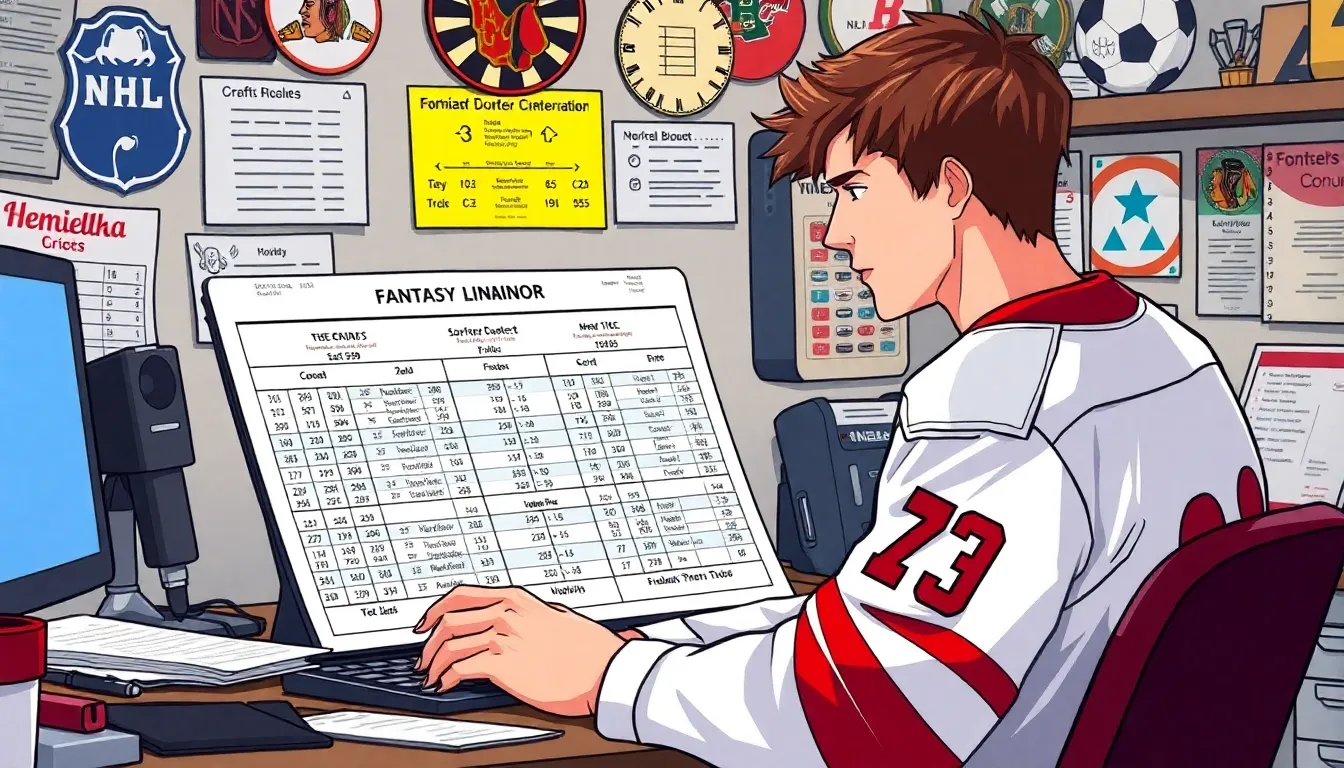As the NHL season approaches, it’s time for fantasy enthusiasts to sharpen their pencils and dust off their draft boards. With a mix of strategy and a dash of luck, assembling a winning roster can feel like trying to score a goal in a crowded crease. But fear not! A solid fantasy draft strategy can turn even the most casual fan into a league champion.
NHL Fantasy Draft Strategy
NHL fantasy draft strategy plays a crucial role in determining the success of a fantasy hockey team. Effective strategies can transform a casual fan’s roster into a competitive powerhouse.
Importance of Research
Research is fundamental before draft day. Knowledge about player stats, injury history, and team dynamics provides a competitive edge. Discovering emerging talents or potential breakout candidates enhances draft decisions. Experts recommend using multiple sources for up-to-date information, including team websites and fantasy analysis platforms. Engaging with forums also offers insights from fellow fantasy enthusiasts. Comprehensive research leads to informed picks and maximizes the chance of assembling a winning team.
Analyzing Player Performance
Player performance analysis is essential for making strategic selections. Examining past seasons reveals trends and helps assess players’ consistency. Focus on metrics such as goals, assists, and plus/minus ratings to gauge overall contribution. Understanding power-play performance adds further depth to evaluations. Player injuries can shift value significantly, making it important to monitor their status. Analyzing performance in specific situations, like playoff appearances, provides additional context. This thorough examination supports making educated decisions during the draft.
Draft Preparation

Effective draft preparation leads to successful fantasy hockey seasons. This phase allows participants to strategize and prepare for their upcoming NHL fantasy draft.
Creating a Player Ranking List
Establishing a player ranking list simplifies draft day decisions. Begin by reviewing previous season statistics from reliable sources. Consider goals, assists, and shots on goal when evaluating players’ performances. Group players into tiers based on projected performance. Players ranked within the same tier often hold similar value. Maintain flexibility in adjusting rankings as offseason changes occur. This adaptability assists in responding to unexpected draft developments.
Knowing Your League Scoring System
Understanding the league scoring system shapes drafting strategies. Point structures typically vary across leagues. Identify whether your league rewards goals, assists, and special teams differently. Some leagues emphasize goalies while others focus on skaters. Preparing for these nuances ensures selections align with scoring rules. Scoring systems influence player values; thus, prioritize players who maximize potential points based on this system. Analyzing how each position scores provides clarity during the draft process.
Draft Day Strategies
Draft day strategies play a crucial role in building a competitive fantasy hockey roster. Understanding various aspects of the draft can enhance decision-making and maximize potential.
Best Position to Draft From
Draft position significantly influences strategy. Early picks often secure top-tier talent, securing elite players who can anchor a team. Conversely, later positions may provide opportunities for grabbing valuable players during a wrap-around. Evaluating each position’s advantage helps in formulating a flexible draft strategy. Knowledge of player rankings and depth also heightens decision-making, ensuring selections align with team needs. Review mock drafts to gauge how player selections vary based on draft positions. This insight leads to informed choices and optimized rosters.
Staying Flexible with Your Picks
Flexibility during the draft process can increase overall competitiveness. Adapting quickly to player availability often opens up better options. Monitoring position runs, such as when goalies or defensemen are drafted, may dictate a shift in focus. Drafters should remain open to adjusting strategies based on emerging opportunities. Evaluating the depth at various positions assists in making real-time decisions that enhance team composition. Keeping an eye on remaining players aids in identifying potential steals, allowing for last-minute adjustments. Prioritize adaptability to ensure a successful fantasy season.
Post-Draft Considerations
Post-draft analysis plays a crucial role in crafting a successful fantasy season. Evaluating team strengths and weaknesses ensures a competitive edge throughout the year.
Evaluating Your Team
Examine player performance closely to identify strengths and weaknesses. Review individual stats like goals, assists, and plus/minus ratings for each player. Compare team dynamics to understand how players complement each other. Monitor injuries and performance trends regularly. Assess overall roster balance, including depth at each position. Adjust strategies based on early-season results and trends in player performance. Address any gaps in the roster quickly to maintain competitiveness.
Making Trade Decisions
Explore trade opportunities to improve roster composition continually. Compare players based on performance metrics and projected future outputs. Assess team needs before initiating trade discussions. Target underperforming players on other teams who may still offer long-term value. Evaluate trade offers carefully, focusing on potential benefits versus risks. Engage with other managers openly to negotiate effectively. Timing plays a key role; targeting trades during an opponent’s injury or slump can maximize advantage.
Conclusion
A well-crafted NHL fantasy draft strategy can set the stage for a successful season. By prioritizing research and preparation fans can navigate draft day with confidence. Understanding player performance metrics and league scoring systems ensures informed decisions that maximize potential points.
Flexibility during the draft is essential as it allows for quick adaptations to player availability. Post-draft analysis and ongoing roster evaluation keep teams competitive throughout the season. Engaging in strategic trades can further enhance team composition and performance.
With the right approach and a willingness to adapt fantasy players can transform their rosters into formidable contenders and enjoy an exciting NHL season.

